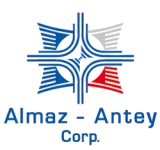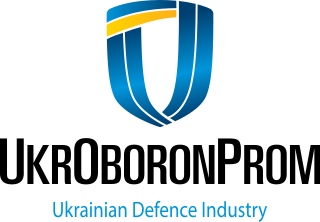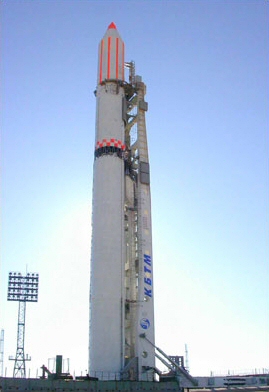
LOMO is a manufacturer of medical and motion-picture lenses and equipment based in St. Petersburg, Russia. The company was awarded three Order of Lenin decorations by the Soviet Union.

The 9K35 Strela-10 is a Soviet highly mobile, short-range surface-to-air missile system. It is visually aimed, and utilizes optical/infrared-guidance. The system is primarily intended to engage low-altitude threats, such as helicopters. "9K35" is its GRAU designation; its NATO reporting name is SA-13 "Gopher".

Moscow Aviation Institute (National Research University) (MAI; Russian: Московский авиационный институт, МАИ) is one of the major engineering institutes in Moscow, Russia. Since its inception MAI has been spearheading advances in aerospace technology both within Russia and worldwide. The university laid emphasis on laboratory instruction in applied science and engineering, specific to the demands of aerospace industry.

The BTR-80 is an 8×8 wheeled amphibious armoured personnel carrier (APC) designed in the Soviet Union. It was adopted in 1985 and replaced the previous vehicles, the BTR-60 and BTR-70, in the Soviet Army. It was first deployed during the Soviet–Afghan War.

The 2K22 Tunguska is a Soviet tracked self-propelled anti-aircraft gun armed with a surface-to-air gun and missile system. It is designed to provide day and night protection for infantry and tank regiments against low-flying aircraft, helicopters, and cruise missiles in all weather conditions. The NATO reporting name for the missile used by the weapon system is SA-19 "Grison".

OPK Oboronprom was a Russian aerospace holding company. The company was involved in helicopter production, engine production, air-defence systems, complex radio-electronic systems and leasing. Russian Helicopters, Oboronprom’s helicopter manufacturing group is the leading Russian designer and manufacturer of rotary-wing aircraft equipment.
The Defence Industry of Pakistan, under the Ministry of Defence Production, was created in September 1951 to promote and coordinate the patchwork of military production facilities that have developed since independence. The ministry also includes seven other specialized organizations devoted to research and development, production, and administration.

JSC Concern VKO "Almaz-Antey" is a Russian state-owned company in the arms industry, a result of a merger of Antey Corporation and NPO Almaz, unifying some of the national military enterprises, in particular, the developers of anti-aircraft defence and cruise missile systems. The organisation is headquartered in Moscow and is the world's eighth-largest defence contractor measured by 2017 defence revenues. In 2017, Almaz-Antey had arms sales of $9.125 billion.

Sergey Pavlovich Nepobedimy was a Soviet designer of rocket weaponry. He was the Head and Chief Designer of the Kolomna Mechanical Engineering Design Bureau (1965-1989). Born in Ryazan, USSR, he graduated from Bauman Moscow State Technical University in 1945 and was directed to the work at SKB-101 of Boris Shavyrin.
KB Mashinostroyeniya or KBM for short is a state defence enterprise, scientific and design R&D centre specialised in missile systems located in Kolomna, Moscow region, Russia. Part of Rostec state corporation.

JSC Tactical Missiles Corporation (KTRV) (Russian: АО «Корпорация Тактическое Ракетное Вооружение», КТРВ) is a major Russian holding company for the manufacturers of weapon (especially missiles), headquartered in Korolyov, Moscow Oblast.

Borys Viktorovych Grynyov is a Ukrainian scientist, public figure, member of the National Academy of Sciences of Ukraine (NAS), Honored Science Worker of Ukraine, Doctor of Engineering Science, Professor and currently Director of the State Fund for Fundamental Research of Ukraine. Chief Researcher of Institute for Scintillation Materials NAS of Ukraine

Ukrainian Defense Industry is an association of multi-product enterprises in various sectors of the defence industry of Ukraine. The company has ceased most of its activities across Ukraine since the 2022 Russian invasion of Ukraine and has relocated much of its production abroad during the war.

Rostec, officially the State Corporation for Assistance to Development, Production and Export of Advanced Technology Industrial Product Rostec and formerly Rostekhnologii, is a Russian state-owned defense conglomerate headquartered in Moscow.
Shvabe Holding is a holding company within the Russian state-owned Rostec group responsible for development and production of high-tech optical-electronic systems both for military and civil purposes, manufacturing of optical, medical and energy-saving equipment.
Concern Radio-Electronic Technologies is a holding company within the Russian state-owned Rostec group that develops and manufactures military specialized radio-electronic, state identification, aviation and radio-electronic equipment, multi-purpose measuring devices, detachable electrical connectors and a variety of civil products.

Luch Design Bureau, located in Kyiv, Ukraine, is a major Ukrainian developer of components for the defense industry.

The defense industry of Ukraine is a strategically important sector and a large employer in Ukraine. After working for several decades mostly for the arms export markets, in 2014 it has moved significantly into increased Ukrainian military procurement since the start of the war in Donbas.

















